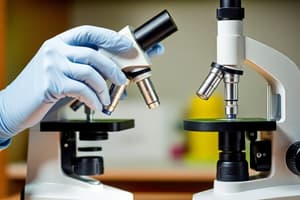Podcast
Questions and Answers
According to the table, how many items will assess a student's ability to describe the position of an object?
According to the table, how many items will assess a student's ability to describe the position of an object?
- 10
- 20 (correct)
- 14
- 40
Based on the table, which cognitive domain has the highest number of test items allocated for describing the uses of light, sound, heat, and electricity?
Based on the table, which cognitive domain has the highest number of test items allocated for describing the uses of light, sound, heat, and electricity?
- Remembering (correct)
- Analyzing
- Understanding
- Applying
In the table, how many test items in total, assess the 'Analyzing' domain across both competencies?
In the table, how many test items in total, assess the 'Analyzing' domain across both competencies?
- 8
- 6
- 4 (correct)
- 2
According to the table, which of the following competencies has more test items dedicated towards the 'Creating' domain?
According to the table, which of the following competencies has more test items dedicated towards the 'Creating' domain?
Based on the table, how many total test items are allocated for assessing the 'Understanding' domain across all competencies?
Based on the table, how many total test items are allocated for assessing the 'Understanding' domain across all competencies?
Which action demonstrates how a rigid object's shape can be changed?
Which action demonstrates how a rigid object's shape can be changed?
If a toy car travels 10 meters in 5 seconds, what does this measurement help determine?
If a toy car travels 10 meters in 5 seconds, what does this measurement help determine?
What term describes the distance an object moves in a specific amount of time?
What term describes the distance an object moves in a specific amount of time?
Which type of graph would best show a car moving at a constant speed?
Which type of graph would best show a car moving at a constant speed?
How can a push affect the motion of a toy car that is already moving?
How can a push affect the motion of a toy car that is already moving?
A child pushes a toy car, then pushes harder. What happens to the car?
A child pushes a toy car, then pushes harder. What happens to the car?
Which action demonstrates a pull changing the shape of an object?
Which action demonstrates a pull changing the shape of an object?
Which is an example of forces not changing the shape of an object?
Which is an example of forces not changing the shape of an object?
Which statement is true about magnetic forces?
Which statement is true about magnetic forces?
Which of these describes a way that objects can affect each other without touching?
Which of these describes a way that objects can affect each other without touching?
What is one of the key functions of energy?
What is one of the key functions of energy?
Which of the following is NOT a form of energy mentioned?
Which of the following is NOT a form of energy mentioned?
How can energy sources be identified?
How can energy sources be identified?
What factor is essential to infer when determining why a bulb lights up?
What factor is essential to infer when determining why a bulb lights up?
Which phenomenon is directly related to the ability of a material to absorb light?
Which phenomenon is directly related to the ability of a material to absorb light?
What describes a good conductor of heat?
What describes a good conductor of heat?
When building a circuit, what outcome results from changing the number of components?
When building a circuit, what outcome results from changing the number of components?
How can you design an experiment related to electromagnets?
How can you design an experiment related to electromagnets?
Which domain of science relates to understanding energy in our environment?
Which domain of science relates to understanding energy in our environment?
Which of the following would best demonstrate the concept of energy causing change?
Which of the following would best demonstrate the concept of energy causing change?
What is the primary function of a simple machine?
What is the primary function of a simple machine?
Which of these is NOT a direct effect of gravity?
Which of these is NOT a direct effect of gravity?
How does friction influence the movement of a car?
How does friction influence the movement of a car?
In terms of sound energy, what happens when you strike a tuning fork?
In terms of sound energy, what happens when you strike a tuning fork?
Which of these is NOT an example of energy transformation?
Which of these is NOT an example of energy transformation?
How does a lever make it easier to lift a heavy object?
How does a lever make it easier to lift a heavy object?
In which of the following scenarios would you find a wedge being used?
In which of the following scenarios would you find a wedge being used?
Which statement best describes the function of a pulley system?
Which statement best describes the function of a pulley system?
Flashcards
Position of an object
Position of an object
The location of an item relative to a reference point, like a person or a chair.
Uses of light
Uses of light
Ways in which light is utilized in daily life, such as for visibility, warmth, and communicating.
Uses of sound
Uses of sound
Applications of sound in life including communication, alerts, and music.
Uses of heat
Uses of heat
Signup and view all the flashcards
Uses of electricity
Uses of electricity
Signup and view all the flashcards
Rigid Objects
Rigid Objects
Signup and view all the flashcards
Soft Objects
Soft Objects
Signup and view all the flashcards
Speed
Speed
Signup and view all the flashcards
Graphs of Speed
Graphs of Speed
Signup and view all the flashcards
Push and Pull
Push and Pull
Signup and view all the flashcards
Force Changes Shape
Force Changes Shape
Signup and view all the flashcards
Properties of Magnets
Properties of Magnets
Signup and view all the flashcards
Non-contact Effects
Non-contact Effects
Signup and view all the flashcards
Guided Activities
Guided Activities
Signup and view all the flashcards
Investigations
Investigations
Signup and view all the flashcards
Energy
Energy
Signup and view all the flashcards
Sources of light energy
Sources of light energy
Signup and view all the flashcards
Sources of sound energy
Sources of sound energy
Signup and view all the flashcards
Sources of heat energy
Sources of heat energy
Signup and view all the flashcards
Good conductors
Good conductors
Signup and view all the flashcards
Light blocking materials
Light blocking materials
Signup and view all the flashcards
Light absorbing materials
Light absorbing materials
Signup and view all the flashcards
Transmitting light
Transmitting light
Signup and view all the flashcards
Electric circuit components
Electric circuit components
Signup and view all the flashcards
Electromagnet strength factors
Electromagnet strength factors
Signup and view all the flashcards
Friction
Friction
Signup and view all the flashcards
Gravity
Gravity
Signup and view all the flashcards
Energy transformation
Energy transformation
Signup and view all the flashcards
Conduction
Conduction
Signup and view all the flashcards
Simple machines
Simple machines
Signup and view all the flashcards
Sound energy
Sound energy
Signup and view all the flashcards
Light energy
Light energy
Signup and view all the flashcards
Electrical energy
Electrical energy
Signup and view all the flashcards
Study Notes
Science 3, 4, 5, and 6 Third Quarter Examinations
-
Table of Specifications (TOS): Documents outlining the distribution of test items across different skills and learning objectives. Used to ensure balanced assessments.
-
Competencies: Skills students are expected to demonstrate. These vary by grade level (3, 4, 5, and 6).
-
Domains: Categories of cognitive skills assessed, such as remembering, understanding, applying, analyzing, evaluating, and creating. The distribution of items across domains is specified in the TOS.
-
Item Numbers: Unique identifiers for each question or task on the test.
-
Total Number of Test Items: The overall count of questions/tasks for each subject.
-
Specific Competencies (Examples):
- Participate in activities to discover and predict how rigid and soft objects change shape.
- Measure distance and time to calculate speed.
- Identify force as changing the shape of objects.
- Use simple equipment to study motion and speed.
- Investigate the properties of magnets.
- Explore the effects of objects not in contact, such as magnets and light.
- Understand the concept of energy in different forms (light, sound, heat).
- Identify and observe energy sources in different environments (school, home, community).
-
Specific Grade Level Competencies (Examples - from Science 5):
- Describe the motion of objects using distance/time relationships.
- Understand why some materials are good conductors of heat/electricity.
- Explain the properties of materials relating to light transmission.
- Design experiments to learn how to make a bulb light.
- Analyze how changing circuit components affects circuits.
- Investigate factors affecting the strength of electromagnets.
-
The information is grade-specific with different competencies and skills being emphasized for each. For example, Science 3 focuses on position/relationships, and Science 5 is more complex involving circuits and electromagnetism.
-
Note the consistent pattern in the structure, with similar elements repeated for each grade level.
Studying That Suits You
Use AI to generate personalized quizzes and flashcards to suit your learning preferences.




